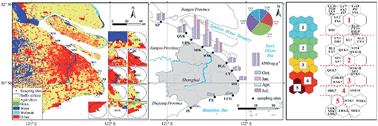Molecular characterization of PAHs based on land use analysis and multivariate source apportionment in multiple phases of the Yangtze estuary, China†
Abstract
Spatial–temporal distributions, source identification, and possible effects of land use patterns on PAHs were studied in overlying water and surface sediments in Yangtze estuarine and nearby coastal areas. The concentrations of PAHs ranged from 172.6 ± 9.3 to 5603.7 ± 548.7 ng L−1, 841.0 ± 36.6 to 31 190.5 ± 3711.5 ng g−1 and 312.3 ± 7.6 to 9081.1 ± 862.3 ng g−1, with mean contents of 1042.9 ng L−1, 8922.9 ng g−1 and 2400.2 ng g−1 in water, suspended particulate matter (SPM) and sediments. PAH concentrations in three phases were higher in dry seasons (January and April) than in rainy seasons (July and October), and showed a distribution pattern as freshwater area > transition area > seawater area. Water and urban (especially for industrial) land uses contributed significantly to the PAH content in water and sediments. Urban and agricultural land uses were identified as important factors for regulating PAH concentrations in the SPM. TOC and BC were crucial controlling factors for the sorption and distribution of PAHs. The stable carbon isotope signatures of TOC and BC indicated the terrestrial origin of PAHs. Multivariate statistical and toxicity assessments revealed that LHK and SDK were contamination hotspots. Traffic emissions contributed 63% of PAH loadings in the three phases, yet biomass/coal combustion contributed over 85% of the toxicity caused by PAHs. Potential ecological and health risks of PAHs were low. We thus conclude that PAH pollution in the study area was primarily of terrestrial origin. BC and TOC were important predictors for PAH fate in the estuary. Urban and agricultural land use and river systems along the estuary were the major input pathways for the PAH loadings.



 Please wait while we load your content...
Please wait while we load your content...